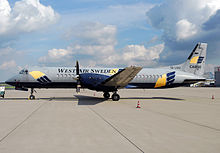BAe ATP
| BAe ATP | |
|---|---|

|
|
| Type: | Turboprop airliner |
| Design country: | |
| Manufacturer: | |
| First flight: |
August 6, 1986 |
| Commissioning: |
May 9, 1988 |
| Production time: |
1988-1996 |
| Number of pieces: |
65 (with prototype) |
The BAe ATP (for Advanced Turboprop ) is a turboprop - commercial aircraft for the transport of cargo or up to 72 passengers on short routes of the British manufacturer British Aerospace . The model was developed as a further development of the Avro 748 .
history
Under the impression of the oil crisis and the increased criticism of aircraft noise , British Aerospace saw good sales opportunities for a quiet and economical short-haul turboprop aircraft .
For the design of the ATP, the airframe of the Avro 748 was used. The hull was lengthened to 26.01 meters and the wingspan was increased to 30.63 meters, increasing the capacity to 64 to 72 passengers. The bow and the tail unit experienced slight changes, and smaller windows with shorter distances were provided.
Instead of the Rolls-Royce Dart engines, the new model received two more economical Pratt & Whitney Canada PW126 turbo-prop engines. The newly developed six-blade propeller came from Hamilton Standard . The ATP was equipped with a glass cockpit .
The first flight took place in 1986. The first production aircraft was delivered to British Midland in 1988 . Due to the competition with the De Havilland Canada DHC-8 and the ATR 42 , only a few customers could be won. A total of 64 aircraft were manufactured in the Woodford and Prestwick plants by 1996 . The main users were British Airways -CitiExpress and West Air Sweden .
In 2001, six ATPs were converted into “ATP Freighters” (ATPF). For this freight version, components from the Avro 748 were again used. This model intended for West Air Sweden made its maiden flight on July 10, 2002 in Lidköping , the airline's home base.
operator


As of February 2013, 35 of the 64 ATP produced are still active:
- Passenger variant
- Freight variant
-
 Indonesia : Deraya Air Taxi (2)
Indonesia : Deraya Air Taxi (2) -
 Luxembourg : West Air Luxembourg (14)
Luxembourg : West Air Luxembourg (14) -
 Sweden : West Air Sweden (8)
Sweden : West Air Sweden (8) -
 United Kingdom : West Atlantic (11)
United Kingdom : West Atlantic (11)
Incidents
From the first flight in 1986 to July 2020, BAe ATP resulted in five total write-offs of aircraft. 50 people were killed in 2 of them. Example:
- On December 11, 1999, a BAe ATP of the Portuguese SATA Air Açores ( aircraft registration CS-TGM ) was flown into a mountain on the Azores island of São Jorge . The machine was on the way from Ponta Delgada to Horta on the island of Faial . The pilots had requested and received clearance for a visual approach when they encountered heavy rain and turbulence. In doing so, they lost sight of the ground. Since they did not use their weather radar or altimeter appropriately and did not adhere to the prescribed minimum altitude, the plane collided with the Morro Pelado volcano near Pico da Esperança . The flight altitude was less than 1000 meters, although the machine was still 56 kilometers from the destination airport. Today a memorial stone commemorates the victims. All 35 people on board were killed in this CFIT ( Controlled Flight into Terrain ).
Technical specifications
| Parameter | Data |
|---|---|
| crew | 2 pilots, 2 flight attendants |
| Passengers | 64-72 |
| length | 26.01 m |
| span | 30.63 m |
| height | 7.14 m |
| Empty mass | 13,595 kg |
| Takeoff mass | 22,930 kg (optionally also 23,678 kg) |
| Cruising speed | 490 km / h / 265 kts |
| Service ceiling | 7620 m |
| Range | 1825 km / 1481 km (fully loaded) |
| Engines | 2 × Pratt & Whitney Canada PW126A -Turboprops with 1978 kW / 2650 shp each |
See also
Web links
- Type certification of the ATP - EASA-TCDS-A.192 (PDF; 85 kB)
- Manufacturer's brochure (PDF, English; 1.93 MB)
Individual evidence
- ↑ ch-aviation.ch - Aircraft Quick Search (English) accessed on February 13, 2013
- ↑ One of them badly damaged in an accident [1]
- ↑ Accident statistics BAe ATP , Aviation Safety Network (English), accessed on August 3, 2020.
- ^ Accident report BAe ATP CS-TGM , Aviation Safety Network (English), accessed on August 3, 2020.
